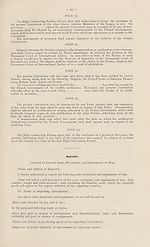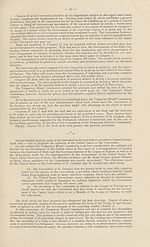Armament > Conference for the control of the international trade in arms, munitions and implements of war
(28)
Download files
Complete book:
Individual page:
Thumbnail gallery: Grid view | List view

— 26 —
ANALYSIS OF THE DRAFT CONVENTION.
It should be pointed out that the work undertaken on this subject by the Temporary Mixed
Commission was based on two articles of the Covenant, Article 23, which makes the following
provision with regard to the control of the international trade in arms:
“Subject to and in accordance with the provisions of international conventions
existing or hereafter to be agreed upon, the Members of the League:
“(d) Will entrust the League with the general supervision of the trade in arms
and ammunition with the countries in which the control of this traffic is necessary in
the common interest”;
and Article 8, the penultimate paragraph of which reads as follows:
“The Members of the League agree that the manufacture by private enterprise of
munitions and implements of war is open to grave objections. The Council shall advise
how the evil effects attendant upon such manufacture can be prevented, due regard
being had to the necessities of those Members of the League which are not able to manu¬
facture the munitions and implements of war necessary for their safety.”
The above articles taken together indicate both the object and the method of the work
of the Commission on this question.
Its object has been twofold: in the first place, to control the trade in arms and munitions
in the countries in which the control of this trade is necessary in the common interest; in the
second place, by controlling the general international trade in arms to prevent as far as possible
the evil effects which the Covenant attributed to the private manufacture of munitions and
implements of war.
The Commission had before it three texts, i.e. the Convention of St. Germain (Document 1,
page 29) and the draft Conventions of Admiral the Marquis de Magaz (Document 3, page 61)
and M. Jouhaux (Document 4, page 64). In virtue of the decision of the Assembly, it was
directed to adopt a text which would be likely to obtain the approval of all States and especially
of all great producing countries.
It therefore adopted as a basis for its work the Convention of Saint Germain, which was amended
and completed, in order to facilitate the adherence of the United States to the future Convention
and to develop and strengthen that part of the said Convention which dealt with the control
of the general trade by incorporating in the new draft certain fundamental ideas contained in
the drafts submitted by Admiral the Marquis de Magaz and M. Jouhaux.
The text finally adopted by the Commission (pages 17 to 26) contains six chapters.
Chapter I, consisting of the first article of the draft, deals with the definition and enumera¬
tion of the arms, munitions and implements of war the international commerce of which is to
be controlled. In this task the Temporary Mixed Commission had the advantage of the technical
co-operation of the Permanent Advisory Commission, and the classification adopted by the
Temporary Mixed Commission has for its basis that which the Permanent Advisory Commission
had prepared at its May session in Paris. In this connection, the Temporary Mixed Commission
endorses the following remarks, to be found in the report of the Permanent Advisory Commission
on the subject:
“After considering the arms and munitions in relation to their intended or possible
use for war, the Commission decided to form three distinct categories.
“The Commission decided that a first category should be set apart for arms and
munitions exclusively designed for war.
“In view of the developments which have been effected in arms manufactured for
commercial purposes, and particularly in sporting rifles, there is little difference between
sporting and military weapons, and the former have acquired a military value which
must be taken into consideration. The Commission accordingly considered it advisable
to make a second category to include arms and ammunition which, without being
designed exclusively for war, were nevertheless capable of being utilised to some extent
for military purposes.
“Lastly, the arms which are not covered by the two previous categories, either
because they are not specially designed for war or because they are not capable of being
utilised for military purposes, have been put into a third category.
“The Commission has thought it desirable to append a note to the list to the effect
that it was considered unnecessary to include therein arms the use of which is prohibited
by international law.”
The Temporary Mixed Commission thought it necessary to add to the arms and munitions
enumerated in Category I of the classification established by the Permanent Advisory Commis¬
sion certain implements of war, as well as certain component parts thereof.
ANALYSIS OF THE DRAFT CONVENTION.
It should be pointed out that the work undertaken on this subject by the Temporary Mixed
Commission was based on two articles of the Covenant, Article 23, which makes the following
provision with regard to the control of the international trade in arms:
“Subject to and in accordance with the provisions of international conventions
existing or hereafter to be agreed upon, the Members of the League:
“(d) Will entrust the League with the general supervision of the trade in arms
and ammunition with the countries in which the control of this traffic is necessary in
the common interest”;
and Article 8, the penultimate paragraph of which reads as follows:
“The Members of the League agree that the manufacture by private enterprise of
munitions and implements of war is open to grave objections. The Council shall advise
how the evil effects attendant upon such manufacture can be prevented, due regard
being had to the necessities of those Members of the League which are not able to manu¬
facture the munitions and implements of war necessary for their safety.”
The above articles taken together indicate both the object and the method of the work
of the Commission on this question.
Its object has been twofold: in the first place, to control the trade in arms and munitions
in the countries in which the control of this trade is necessary in the common interest; in the
second place, by controlling the general international trade in arms to prevent as far as possible
the evil effects which the Covenant attributed to the private manufacture of munitions and
implements of war.
The Commission had before it three texts, i.e. the Convention of St. Germain (Document 1,
page 29) and the draft Conventions of Admiral the Marquis de Magaz (Document 3, page 61)
and M. Jouhaux (Document 4, page 64). In virtue of the decision of the Assembly, it was
directed to adopt a text which would be likely to obtain the approval of all States and especially
of all great producing countries.
It therefore adopted as a basis for its work the Convention of Saint Germain, which was amended
and completed, in order to facilitate the adherence of the United States to the future Convention
and to develop and strengthen that part of the said Convention which dealt with the control
of the general trade by incorporating in the new draft certain fundamental ideas contained in
the drafts submitted by Admiral the Marquis de Magaz and M. Jouhaux.
The text finally adopted by the Commission (pages 17 to 26) contains six chapters.
Chapter I, consisting of the first article of the draft, deals with the definition and enumera¬
tion of the arms, munitions and implements of war the international commerce of which is to
be controlled. In this task the Temporary Mixed Commission had the advantage of the technical
co-operation of the Permanent Advisory Commission, and the classification adopted by the
Temporary Mixed Commission has for its basis that which the Permanent Advisory Commission
had prepared at its May session in Paris. In this connection, the Temporary Mixed Commission
endorses the following remarks, to be found in the report of the Permanent Advisory Commission
on the subject:
“After considering the arms and munitions in relation to their intended or possible
use for war, the Commission decided to form three distinct categories.
“The Commission decided that a first category should be set apart for arms and
munitions exclusively designed for war.
“In view of the developments which have been effected in arms manufactured for
commercial purposes, and particularly in sporting rifles, there is little difference between
sporting and military weapons, and the former have acquired a military value which
must be taken into consideration. The Commission accordingly considered it advisable
to make a second category to include arms and ammunition which, without being
designed exclusively for war, were nevertheless capable of being utilised to some extent
for military purposes.
“Lastly, the arms which are not covered by the two previous categories, either
because they are not specially designed for war or because they are not capable of being
utilised for military purposes, have been put into a third category.
“The Commission has thought it desirable to append a note to the list to the effect
that it was considered unnecessary to include therein arms the use of which is prohibited
by international law.”
The Temporary Mixed Commission thought it necessary to add to the arms and munitions
enumerated in Category I of the classification established by the Permanent Advisory Commis¬
sion certain implements of war, as well as certain component parts thereof.
Set display mode to:
![]() Universal Viewer |
Universal Viewer | ![]() Mirador |
Large image | Transcription
Mirador |
Large image | Transcription
Images and transcriptions on this page, including medium image downloads, may be used under the Creative Commons Attribution 4.0 International Licence unless otherwise stated. ![]()
| League of Nations > Armament > Conference for the control of the international trade in arms, munitions and implements of war > (28) |
|---|
| Permanent URL | https://digital.nls.uk/195382127 |
|---|
| Shelfmark | LN.IX |
|---|
| Description | Over 1,200 documents from the non-political organs of the League of Nations that dealt with health, disarmament, economic and financial matters for the duration of the League (1919-1945). Also online are statistical bulletins, essential facts, and an overview of the League by the first Secretary General, Sir Eric Drummond. These items are part of the Official Publications collection at the National Library of Scotland. |
|---|---|
| Additional NLS resources: |
|

